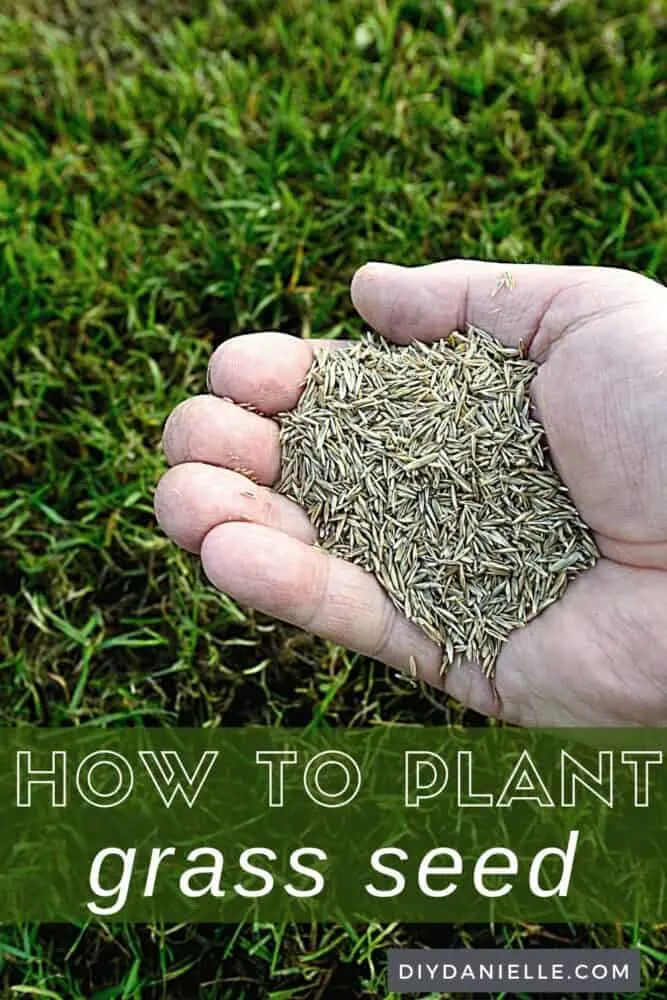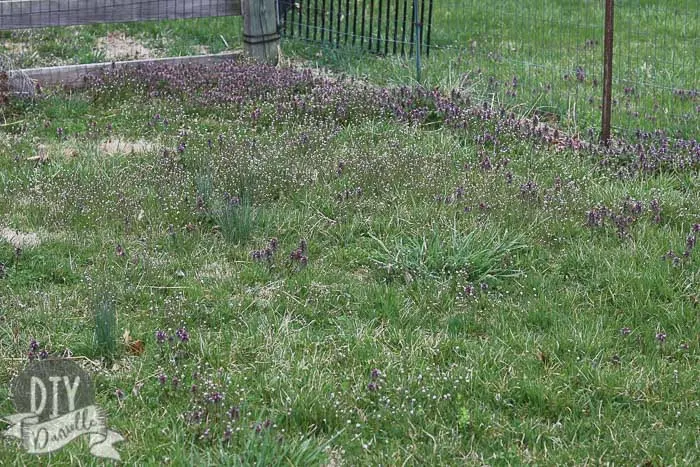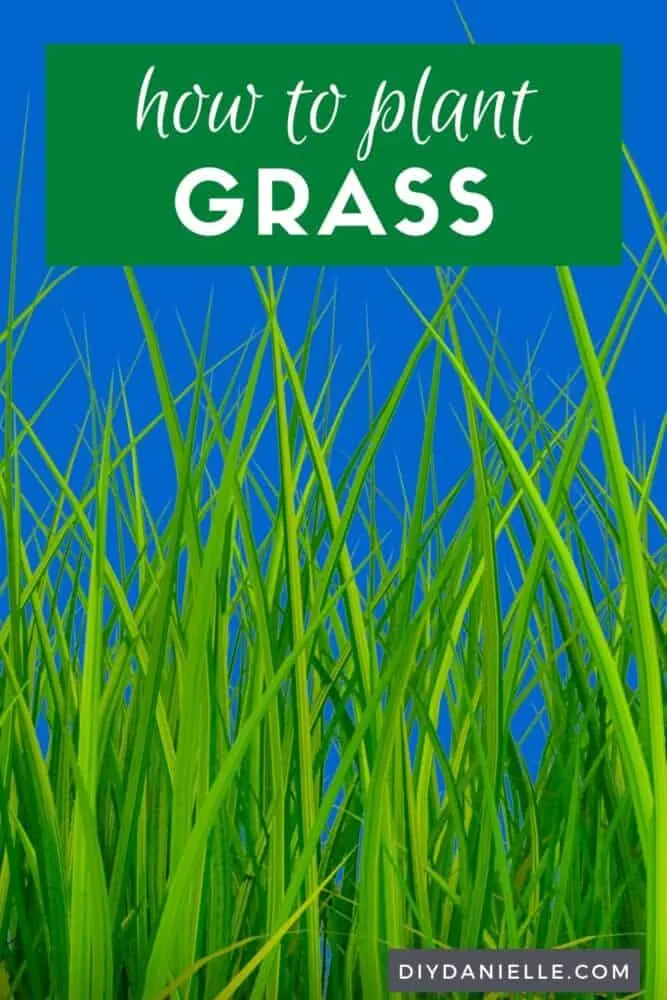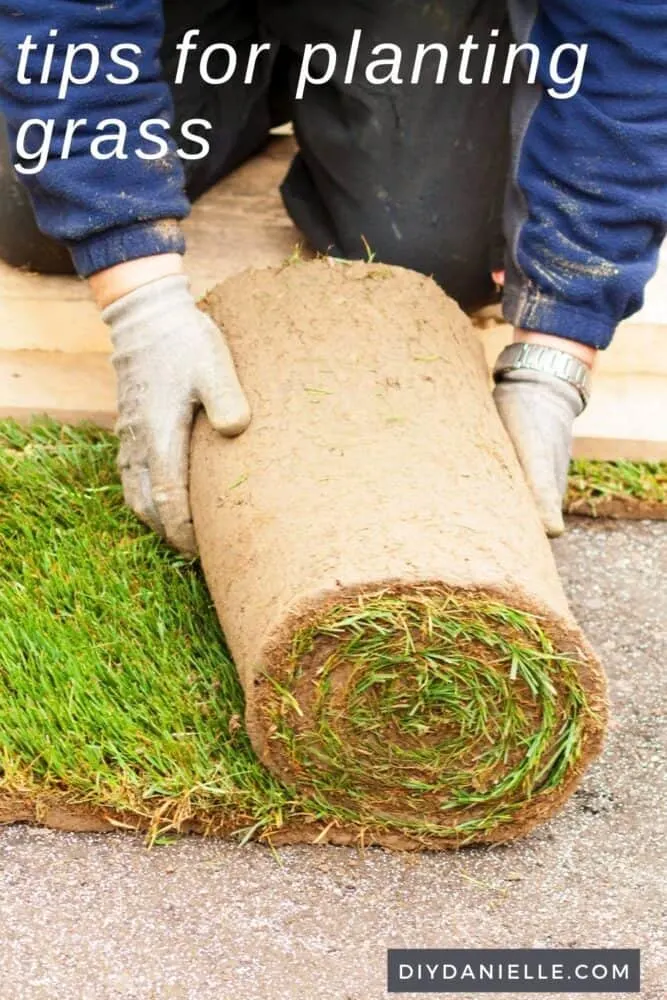
This beginner’s guide will explain how to plant grass seed to either seed a lawn from scratch or how to plant it on an existing lawn.
This post may contain affiliate links which may earn me commissions should you click through them and take certain actions. As an affiliate for Amazon, Cricut, xTool, Home Depot, and other sites, I earn from qualifying purchases. Please DIY carefully. View my full legal disclosures here.
Please read the whole post so you don’t miss any important information!
I never knew how fascinating grass was until I had the county come out to give me advice on clearing our land and preparing it for horse pasture. We started talking about different types of grasses, and how you can mix grass seed together to produce different effects.
We have clover mixed with fescue and blue grass. Grasses grow at different speeds, tolerate different temperatures, and some are perennials vs. annuals.
We also have a variety of wild “weeds” that I don’t have any intention of battling because they’re good for the bees and quite beautiful. This is a portion of our lawn that was unmowed, early in the Spring. Isn’t it pretty?

There’s different types of grass to plant if you want to grow hay or straw; if you’re growing hay, you don’t want certain weeds in the bales because some weeds are dangerous to horses and other animals.
Technically, the term “grass” includes not only the grass you grow for your lawn, but also rice, wheat, corn, and barley. When these plants all “go to seed” (grow tall enough to produce a seed head at the top of the grass), they look similar. It’s pretty interesting to research! But we’re going to stick with a conversation about the types of grass you grow for a lawn.
Here are some tips on how to plant grass for a lawn or pasture on your property.
How to Plant Grass
Green grass is one of the most coveted characteristics of any lawn or pasture. For some yards, it can be tricky getting lush, green grass to grow instead of pesky weeds. In order to cultivate the growth of new grass, it is important to know how to properly prepare the soil and sow the seed. If you are looking to plant grass on a pasture or lawn, there are a few things you will need to know before you get started.
Which Type of Grass Should I Use?
Selecting the right type of grass is important for many reasons. You want to plant a kind that will thrive in your specific climate and soil composition.
Not all grasses are alike, and you will do yourself a disservice by spending time and money on planting grass seeds that don’t grow well in your area.
Most types of grasses fall into two categories:
- Warm Season- for warmer regions such as the Southern US
Includes: Bermuda, St. Augustine, Centipede, Zoysia, and Carpet
- Cool Season- for regions with extreme temperature changes such as the Northern US
Includes: Kentucky, Fescue, Bent, and Rye
The United States Department of Agriculture offers a directory for the best type of turf grass for your area.
In addition to selecting grass that grows well in your climate, you also want to consider the purpose of the land where the grass will be planted. A pasture will benefit from a different variety of grass than a lawn.
Most types of lawn grasses are perennials, but if you plant a grass that can’t survive the winter in your zone, it would be considered an annual.
There are also some grasses that are annuals, however, such as crabgrass, annual bluegrass, and annual ryegrass. People sometimes use fast growing annuals as a cover crop to prevent soil erosion and to cover up bare spots in a lawn. This gives slow growing perennial grasses the time to fill in.
Annual grasses can look like brown areas in your grass during the winter. With annual grasses, you need to either let the grass go to seed or reseed each year.
When choosing grass for a pasture, you need to consider if animals will graze, and if so, which type. Many farm supply stores will carry grass seed blends designed to feed a specific animal or group of animals.
The county went over what types of grasses we have; they mentioned that fescue tends to have a very high sugar content after the first or second frost. This is a problem for grazing animals because if an animal grazes on grass that is heavy in sugar, they can get bloat (goats, sheep) or founder (horses). This isn’t to say that fescue is unsafe for horses, goats, or sheep, but if they’re prone to these health issues, it’s smart to use a grazing muzzle or keep a dry lot (a pasture with no grass) for them to use during certain parts of the year.
Looking to keep track of important information about your home? Here’s a printable that allows you to track planned renovations, completed renovations, contractors, appliance records, paint colors, and more!
When is the Best Time to Plant Grass?
Timing can be crucial to the successful growth of grass. You want to plant seeds so that the growing cycle aligns with weather conditions and available nutrients in the soil.
The ideal time of year to plant grass will vary depending on the area in which you live. As a general rule of thumb, warm season grasses are planted in early spring or summer while cool season grasses grow best when planted in late summer or fall.
In order to identify a more definite timeframe, consult a climate zone map for planting grass.
How Do I Plant Grass?
Once you have purchased the type of grass seed you need and have determined the appropriate season for planting, you are then ready to sow the seeds in the ground. There are several steps involved in the process of planting grass:
Step 1: Preparation
Preparing the soil for sowing is essential for the growth and development of the grass. You may want to perform a soil test first to check the balance of nutrients. A soil test is not necessary; however, it can be very beneficial in the long run.
Preparing the ground will depend on if you are seeding a lawn from scratch or on an existing lawn.
To prepare a lawn from scratch:
- Till or loosen the top 3 inches of soil. You can also add composted materials to the top of the soil to improve the quality of the soil.
- Remove large clumps of soil or other items such as sticks and rocks
- Try to level the ground as much as possible
- Avoid using weed killers around the time of planting seeds
To prepare an existing lawn:
- Mow the grass very short
- Remove any sticks or rocks
- Tear up any dead grass, if possible
If your lawn contains hard soil, the process of preparation includes additional steps. You will need to aerate the top layer of soil using an aerator machine. After that has been completed, add compost before sowing the seeds.
Step 2: Plant the Seeds
For small areas, seeds can easily be spread by hand. In order to cover larger areas, you will need to use a spreader machine. When using this machine, the rate at which the seed is spread will vary depending on the type of grass. Be sure to check the instructions on the packaging for the spreading rate. One method to ensure even coverage is to sow half of the seeds in one direction and the other half in the opposite direction, creating a crisscross pattern.
Step 3: Cover the Planted Seeds
For an existing lawn, all you will need to do is lightly rake the seed into the ground. If you are planting grass from scratch, cover the seeds with around ¼ inch of soil. Then, to keep the seeds in place, you can layer weed-free straw or an erosion control blanket on top.
Step 4: Watering the Seeds
Immediately after the seeds have been planted, the yard will need to be lightly watered 1-2 times per day. This is to encourage germination and the first stages of growth. When the grass reaches one inch in height, watering can be cut back to once per day. After the grass grows to two inches, watering frequency can be decreased even more.
Step 5: Mow the New Grass
Once the newly planted grass has reached 2 ½ to 3 inches in height, it is ready to be mowed for the first time. After you have mowed 2 additional times, you can now reduce watering to one time per week.
How to Plant Grass Seed on Hard Dirt
Often the soil becomes compacted over time with cars and other “traffic” (animals, humans, vehicles, etc) running over it all the time. To plant grass seed on hard dirt, you want to loosen the soil by tilling or using an aerator on the soil. You can also add composted materials on top of the hard dirt to plant your grass seed in.
How Long Does Grass Take to Grow?
Grass can take between 7 to 30 days to germinate (start growing), but this depends on the type of grass. Many people mix different types of grass seed; this allows faster growing grass to start growing and filling in the bare space, but allows the other types of grass time to grow in as well.
Alternatives to Planting Grass
If your yard has patches of dead or missing grass, planting new grass seed is not the only option. You can always add rock, mulch, or dirt on the area to create a unique landscaping design. Some people plant thyme, clover, and other herbs for ground cover as an alternative to grass. Some plants never grow tall so they don’t require mowing (or as frequent mowing).
For larger areas, a flower or vegetable garden might be an ideal solution.
Many people opt for laying sod. Sod is grass that comes in rolls that you can unroll and lay down on bare soil. It’s a common method to quickly produce a lawn, but it requires careful watering to ensure it “takes.” Our lawn at our last home was sod, but I hated it because it was difficult to dig up when we wanted to put in a garden bed. The mesh used to hold the sod together didn’t biodegrade and often got caught up in our tiller.
Here are two ideas for revamping any grassless areas of your lawn:
- How to Plant a Garden and Install a Path to Help with Water Drainage
- How to Fix Dead Grass from an Above Ground Pool
Whether you decide to plant new grass, cover up the dirt patch, or turn it into a garden, the best solution will always be one that suits your needs. Remember that grass requires water and sun to grow, just like other types of plants.
Planting grass can require a significant amount of effort in the beginning, but once the grass has reached a certain height it is relatively easy to maintain. Taking on this project will allow you to enjoy vibrant, green grass for many years to come.
Ever wondered if an automatic lawnmower is worth the price tag? Here’s my review of the Husqvarna Automower. It’s been fantastic at keeping our back lawn manicured without leaving behind obvious leaf and grass clippings.
Please share and pin this post! If you make this project, share it in our Stuff Mama Makes Facebook Group. We have regular giveaways for gift cards to craft stores. You can also tag me on Instagram @doityourselfdanielle; I love seeing everything you make!



Google Web Story: How to Plant Grass Seed


Gracelyn
Sunday 5th of June 2022
An excellent, comprehensive article!